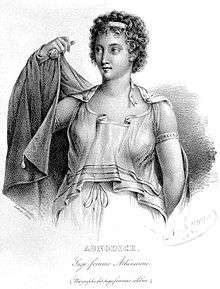Agnodice
| Agnodice | |
|---|---|
 Agnodice dressed in all white with darker clothing as a part of her disguise as a male physician. | |
| Born | |
| Nationality | Greek |
| Era | Ancient philosophy |
| School | Western philosophy |
Main interests | |
Notable ideas | |
Agnodice or Agnodike (Ancient Greek: Ἀγνοδίκη, Greek pronunciation: [aŋnodíkɛː] c. 4th century BCE) was the first female Athenian physician, midwife, and gynaecologist, whose story was recorded by Gaius Julius Hyginus.[1] Hyginus, who lived in the 1st century BCE, wrote about Agnodice in his Fabulae.[2]
Early life
Agnodice was born into a wealthy family of the Greek city-state of Athens. Her desire to become a physician initiated from witnessing increased numbers of women dying or undergoing painful childbirths. Though women were allowed to learn gynecology, obstetrics, healing, and midwifery in the time of Hippocrates, after his death the leaders of Athens discovered that women were performing abortions, and made becoming a female doctor a capital crime.[3] Agnodice, determined to become a physician and help the women of Athens, cut her hair and donned the clothes of a man to pursue medical training. Agnodice then used an alleged friend's sickness to account for her future leave to pursue medical training.[4] She then left Athens to study medicine in nearby Egypt, where women played an important role in the medical community.[4]
Medicine
Agnodice received her medical education in Alexandria, and studied under Herophilos,[3] the great anatomist of her day.[5] Soon after acquiring the requisite qualifications, she continued to dress as a man in order to treat the women of Athens. One day, Agnodice heard a woman crying out as she was undergoing labor. Agnodice then went to care for the women in labor, but the woman refused male aid. After revealing herself as a woman, the woman allowed Agnodice to treat her successfully. During the time, women dreaded calling in professional assistance. Agnodice symbolized the trust and comfort between women aiding women. Before long, many women heard about Agnodice being disguised as a man and sought for her care. As Agnodice's popularity grew, the women from the city of Athens began to seek her aid over that of the male physicians.
Trial
When male physicians began to see that their services were no longer desired by women, the male physicians began to accuse Agnodice of seducing the women and the women were accused of feigning illnesses.[6] Agnodice was then tried before a group of jealous husbands and rival doctors for seducing the women of Athens. When Agnodice was brought before the court assembled on a hill near Athens called Areopagus, the men began to condemn her. She then lifted her tunic to reveal her true identity and was condemned further by the men of Athens for her deceit and false pretenses.[3] With a crime warranted of execution if carried out, Agnodice then convinced the judges that it was impossible she could be guilty of the alleged crimes the men claimed upon her. Her adversaries then sought to condemn her for violating the law in which women were not allowed to study any branch of medicine.[6] Before the judges ruled on the trial, a crowd of women arrived at her trial to praise her successes as a physician and chastised their husbands for trying to execute Agnodice.[7][6][8] After a short debate, Agnodice was acquitted from her charges and the Athenian law was changed to allow women to be treated by female physicians in Athens.[6][1]
Influence on women in medicine
Before Agnodice, women were taking care of the sick, as well as trying to figure out how the body worked and causes of diseases. Women were also midwives, helping deliver babies, but were not allowed to practice medicine.[4] For the Greeks, Agnodice's trial brought changes with the Athenian law which thereby allowed women to study medicine. Agnodice's story has also been used through the seventeenth century as a tale for midwives to defend themselves against male-dominated professions seeking to incorporate the study of medicine into childbirth.[9]
Mythological theory
Agnodice might have been a mythical figure.[3] The 2002 book The International Encyclopedia of Women Scientists cites her name as one piece of evidence for their theory - Agnodice in Greek translates to "chaste before justice"; a common practice in Greek myths was to name characters after their virtues, although it was not uncommon for living persons to be given similar names. The second argument made by the book is Agnodice dramatically revealing her sex by lifting her skirt. They consider this gesture another popular device in myths, as statuettes of women doing so were considered in the Classical period to have power against evil.[9] Nevertheless, Agnodice has become a symbolic figure for doctors in recent times.[7]
Notes
- 1 2 Yount 1999, p. 2.
- ↑ Hyg. Fab. 274.
- 1 2 3 4 Oakes 2002, p. 3.
- 1 2 3 Kirsh 2002, p. 7-8.
- ↑ Alic 1999, p. 6.
- 1 2 3 4 Newman 1807, p. 1-2.
- 1 2 Oakes 2002, p. 4.
- ↑ Alic 1986, pp. 29-30.
- 1 2 Women in Medicine.
References
- Alic, Margaret (1986), Hypatia's Heritage, Beacon Press, ISBN 9780807067314
- Hyginus, G. Julius, Grant, M., ed., Fabulae, www.theoi.com/Texts/HyginusFabulae5.html#274
- Kirsh, Sharon; Kirsh, Florence (2001), Fabulous Female Physicians, Second Story Press, ISBN 9781896764436, retrieved 6 September 2014
- Newman, Jeremiah Whitaker (1807), A New Volume of the Lounger's Common-place Book: Containing One Hundred Articles, None of which Have Been Printed in Any of the Former Volumes ..., Longman, Hurst, Rees and Orme, retrieved 6 September 2014
- Oakes, Elizabeth H. (2002), International Encyclopedia of Women Scientists, Facts On File Inc., ISBN 0-8160-4381-7
- Women in Medicine, Claude Moore Health Sciences Library, University of Virginia, retrieved 2015-06-01
- Yount, Lisa (1999), A Biographical Dictionary of Women in Science and Math, Facts on File Library of World History, Facts On File, Inc., ISBN 0-8160-3797-3